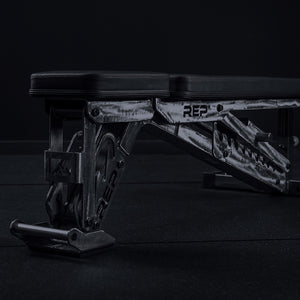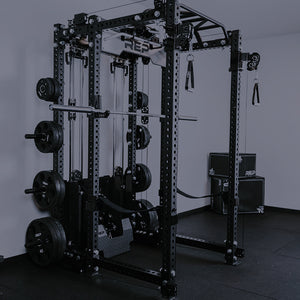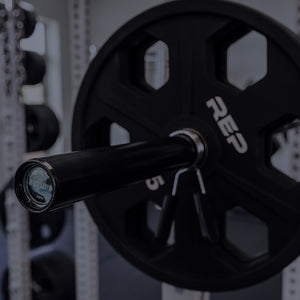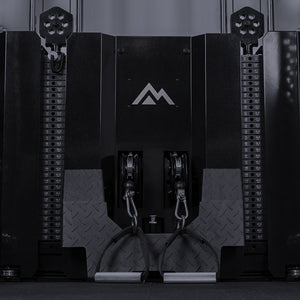
Starting a new fitness journey can be both exciting and overwhelming, especially when you walk into a commercial gym for the first time. After New Year’s, many people set fitness resolutions and goals, like weight loss (aka fat loss) or building strength, but it can be confusing to figure out which machines to use and how to use them properly.
No sweat (well, not figuratively). Help is here.
Let’s break down the basics – from the names of popular gym machines to how to use them correctly and which muscle groups they target.
Gym Equipment Names: A Beginner's Guide
When you enter a gym, you’ll typically find rows of gym machines for arms, legs, core, and total-body work — each piece specifically designed to work different parts of your body. Here’s a list of some of the most common types of gym machines you'll encounter:
Equipment for Cardio Exercise
Treadmill: A go-to for cardio workouts, treadmills are great for walking, jogging, or running. They help with weight loss by burning calories and improving cardiovascular fitness. There are various types of treadmills, including self-powered “runners.”

Elliptical: This machine provides a low-impact, full-body workout, engaging your arms, legs, and core while being easy on the joints.
Rower: A rower provides a full-body workout, getting your back, legs, and arms in on your cardio efforts. Many of these pieces of equipment have a dampener on the side of the fan that allows you to adjust air flow. A higher setting creates more wind-resistance, making it more difficult to row, while a lower setting limits the air flow and makes it easier to pull on each stroke.
Exercise Bike: There are three types of exercise bikes you may encounter in your gym. An upright bike has you seated with an upright posture, a recumbent bike has you seated with your back rested against a backrest, and an air bike utilizes your upper-body to push and pull on the handles while your legs pedal aginst air resistance.

TIP: Check out the Strive Series Collection, REP's cardio equipment lineup, featuring a curved treadmill and airbike with VPR™.
Leg Machines at the Gym
Leg Press: Ideal for strengthening your legs, the leg press targets the quadriceps, hamstrings, and glutes, making it a great choice for anyone looking to build lower-body strength.
Leg Extension: This machine targets your quadriceps, the muscles in the front of your thighs. It’s great for isolating and strengthening the quads, making it a key exercise for building leg strength and muscle definition.
Hamstring Curl: This machine works the muscles at the back of your thighs, helping to strengthen your hamstrings. It’s ideal for balancing out your leg strength and can be used seated or lying down, depending on the machine type.
Equipment for Upper-Body Exercise
Lat Pulldown: If you're working on your back muscles, the lat pulldown cable machine is essential. It focuses on your lats, traps, and biceps, helping you build upper body strength.
Chest Press: Perfect for those targeting chest muscles, the chest press machine mimics the movement of a bench press and works your pecs, shoulders, and triceps.
Seated Row: This machine/cable machine is great for building back strength, specifically targeting your upper back, lats, and biceps.
Bicep Curl Machine: A favorite for arm exercises, this machine isolates the biceps to help build strength and tone your arms.
Equipment for Total-Body Exercise
Smith Machine: A versatile piece of equipment that allows you to perform various exercises like squats, bench presses, and shoulder presses with guided movement. REP's Smith Machine attachment connects with comptaible power racks and provides extra stability, making it a safe option for beginners learning these lifts.

Cable Machine: This adjustable machine (also called a functional trainer) with thin cables is perfect for targeting a variety of muscle groups, including arms, chest, back, and shoulders. With different handle attachments, it allows for exercises like cable rows, tricep pushdowns, and chest flies, offering endless options for a full-body workout.
Learn what all the different kinds of cable attachments are here.

This basic gym equipment are designed to guide your form and help you get used to resistance training. As a beginner, it’s important to start with machines because they ensure proper range of motion and reduce the risk of injury.
Free Weights in the Gym
In addition to gym machines, free weights like dumbbells, barbells, and kettlebells are valuable tools for anyone starting their fitness journey. Free weights offer a different kind of workout compared to machines, as they require more balance and engage stabilizing muscles.
Here's what you need to know about incorporating free weights into your routine:
Dumbbells: These are perfect for a wide range of exercises, from bicep curls and shoulder presses to goblet squats and lunges. Dumbbells are great for targeting smaller muscles, like those in your arms and shoulders, while also improving balance and coordination.

Barbells: Barbells are often used for compound movements like squats, deadlifts, and bench presses, which work multiple muscle groups at once. They’re ideal for building overall strength and muscle mass, making them a popular choice for beginners looking to progress quickly.

Power Rack: A power rack allows you to perform barbell exercises safely by providing adjustable safety bars and a stable setup. This combination is ideal for building overall strength, especially for beginners looking to progress quickly.

Bench Press: A staple in any gym, the bench press is perfect for building chest, shoulder, and tricep strength. It can be performed with a barbell in a power rack or on a dedicated bench press setup.

Kettlebells: These weights are fantastic for dynamic movements like kettlebell swings and goblet squats. They help build power and improve cardiovascular fitness while strengthening your core, back, and legs.

Freeweights vs. Machines
Freeweights consist of the equipment that you're 100% in control of when they're lifted, swung, curled, and pushed. Think moves performed using barbells, kettlebells, and dumbells. Compared to machines — like a Smith machine, Leg Curl/Leg Extension, Bicep Curl machine — freeweights require a greater amount of stability, forcing stabilizer muscles to engage.
Using a machine takes much of that requried stability out of the equation, allowing you to focus all of your effort and attention on the isolation of a dedicated muscle. Because of this, machine's may be better tools for beginners who are becoming familiar with a movement or older adults looking for a safe means of strength training. However, depending on a machine's adjustability, they may not be suitable for users of all heights, sizes, and builds.
How to Use Gym Equipment Correctly
For beginners, learning how to operate gym equipment properly is crucial to avoid injury and maximize results. Here's a simple guide to operate the machines properly:
Start Slow: Begin with light weights or low resistance to get familiar with the movement.
Adjust the Settings: Most machines allow you to adjust the seat or handles. Make sure everything is set to your height and body size for comfort and proper alignment.

Watch Your Form: Keep your back straight, engage your core, and avoid jerky movements. Focus on slow, controlled motions for each rep to get the most out of the exercise. Want help with how to perform exercises correctly?
Check out our “Training” section for guidance on specific exercises, such as:
- How to do Dumbbell Rows
- How to Dumbbell Bench Press
- How to do Dumbbell Side Raises
- How to do a Seated Cable Row
- How to do a Lat Pulldown
- How to Get Better at Push-Ups
- How to Improve Your Pull-Ups
Ask for Help: If you're unsure how to use a machine, don't hesitate to ask a gym trainer for guidance.
How to Use Free Weights Correctly

Start with Light Weights: Begin with a weight that allows you to complete 8-12 reps with good form. It’s better to start lighter and focus on your technique than to risk injury by lifting too heavy too soon.
Master the Basics: Key exercises like squats, deadlifts, and shoulder presses are essential for building a solid foundation. Focus on learning the proper form for these movements, as they will become the core of many strength-training routines.
Engage Your Core: When using free weights, keep your core engaged and maintain a neutral spine to prevent lower back strain. This helps stabilize your movements and ensures that you're targeting the right muscles.
Ask for Guidance: Just like with machines, if you’re unsure how to perform an exercise correctly, don’t hesitate to ask a gym trainer for tips or watch tutorials for proper form.
Benefits of Using Free Weights
Free weights offer several advantages over machines, particularly when it comes to building functional strength and flexibility. They allow for a wider range of motion, helping you mimic real-life movements more effectively.
For men and women with New Year’s resolutions to build strength or tone specific muscle groups, free weights are an excellent complement to machine-based workouts, providing variety and helping you progress faster.
By combining basic gym machines with free weight exercises, you’ll have a balanced workout that targets key muscle groups like your arms, chest, and back, while also improving your overall strength and coordination. Free weights can take your fitness routine to the next level, making them a must-try for beginners who are serious about their workout goals.
Types of Equipment for Different Muscle Groups
Knowing which machine to use for specific muscle groups can help you create an effective workout plan that aligns with your fitness goals. Whether you’re looking to tone your arms, build a strong chest, or strengthen your back, there’s a machine for you.
Arms: Use the bicep curl machine, tricep extension machine, cable machine, bench press, dumbbells, kettlebells, or barbell to target your upper arms. This equipment can isolate your biceps and triceps, helping you strengthen your arms.
Back: To work your back, try the lat pulldown machine or seated row machine. These focus on your lats, traps, and rhomboids, helping you develop a strong upper back.
Chest: For chest muscles, the chest press machine or bench press are your best bet. They engage your pecs while also working your shoulders and triceps for a well-rounded upper body workout.
Setting New Year’s Fitness Goals
As you set your New Year’s fitness goals, whether it's fat loss, building muscle, or improving cardio, it’s important to have a well-rounded workout plan. Incorporating machines into your routine can help you stay on track with your resolution, offering structured workouts that target specific muscle groups. Don’t be afraid to mix in cardio machines like the treadmill or elliptical for fat burning and overall fitness.
Remember, every expert started as a beginner. By using these gym machines properly and staying consistent, you’ll be well on your way to achieving your fitness goals. Whether you want to focus on arms, chest, or back, these machines will guide you toward a stronger, healthier version of yourself.
As you step into the gym after New Year’s with your fitness resolution in mind, start with the basics, be patient, and give yourself time to learn. Your gym journey is about progress, not perfection!
Learn More
11 Tips to Actually Keep Your New Year’s Fitness Resolutions
8 Tips to Stay on Track With Your Fitness Goals During the Holidays
How Often Should You Work Out?
Why Are Rest Days So Important?
How to Properly Warm Up Before Lifting Weights
FAQs
What is the Smith machine gym purpose?
A Smith machine is a guided barbell fixed onto a moving path, with functionality that allows you to rack the weight at various heights. This piece of equipment is great for beginners since movements require less stability to maintain. Additionally, since it's often times easier to setup and you can rack and re-rack the weight at various heights, more experienced lifters may find it beneficial for heavier lifts when they don't have an available spotter.
Aimee Heckel, CPT, is a health and fitness journalist with over 20 years of experience. She set an all-time world-record deadlift in her division across all powerlifting federations at Mr. Olympia. In addition, she earned a national deadlift record and 18 Colorado state records. Heckel also has nine world records in grip sport, a pro card in natural figure bodybuilding, four first-place bodybuilding titles, and was named IPE Ms. Colorado Figure.
similar to this
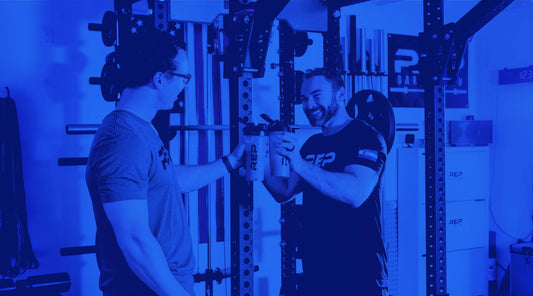
NEWSLETTER SIGNUP
Product launch information, promotions, blogs, and REP news.

